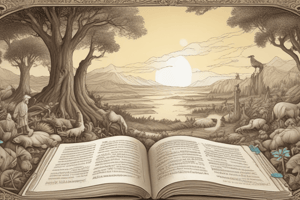Podcast
Questions and Answers
Expository writing primarily aims to entertain the reader.
Expository writing primarily aims to entertain the reader.
False (B)
Descriptive writing allows the writer more artistic freedom than expository writing.
Descriptive writing allows the writer more artistic freedom than expository writing.
True (A)
Persuasive writing is focused on providing the author's opinion without any evidence.
Persuasive writing is focused on providing the author's opinion without any evidence.
False (B)
An example of expository writing is a textbook.
An example of expository writing is a textbook.
Descriptive writing uses facts and figures to present information.
Descriptive writing uses facts and figures to present information.
The aim of narrative writing is to explain a topic logically.
The aim of narrative writing is to explain a topic logically.
The municipal government of Happyville is mentioned as unanimously approving the bike trails in 2017.
The municipal government of Happyville is mentioned as unanimously approving the bike trails in 2017.
Persuasive writing is often found in job applications.
Persuasive writing is often found in job applications.
Persuasive writing aims to tell a story, whether real or imaginary.
Persuasive writing aims to tell a story, whether real or imaginary.
The Happyville Bike Trail is described as the 'glittering gem' of new infrastructure in Happyville.
The Happyville Bike Trail is described as the 'glittering gem' of new infrastructure in Happyville.
Narrative writing can include elements such as dialogue and characters.
Narrative writing can include elements such as dialogue and characters.
The author of the persuasive writing provides factual statements about the bike trail facilities.
The author of the persuasive writing provides factual statements about the bike trail facilities.
The bike trail in Happyville is described as only three miles long.
The bike trail in Happyville is described as only three miles long.
A narrative piece is structured in chronological order.
A narrative piece is structured in chronological order.
In the example of narrative writing, the author uses third-person perspective.
In the example of narrative writing, the author uses third-person perspective.
Human interest stories can be classified as narrative writing.
Human interest stories can be classified as narrative writing.
Flashcards are hidden until you start studying
Study Notes
Types of Writing
- Four main types: Expository, Descriptive, Persuasive, Narrative.
Expository Writing
- Most prevalent writing genre, focused on explanation and information.
- Topics approached from a logical standpoint.
- Common examples: textbooks, business documents, technical writing, instructions.
- Characterized by objective facts without personal opinions.
- Example illustrates the approval of bike trails in Happyville, detailing logistics and benefits.
Descriptive Writing
- Aims to create vivid imagery, engaging all five senses.
- Provides authors more artistic license than expository writing.
- Common contexts include fiction, poetry, advertising, and journaling.
- Example depicts children enjoying a bike trail, emphasizing visuals and sensory details.
Persuasive Writing
- Seeks to influence readers to adopt the author's viewpoint.
- Incorporates personal opinions backed by evidence to sway opinions.
- Common formats: advertisements, opinion pieces, reviews, and job applications.
- Example presents the bike trail as an attractive feature of Happyville to persuade readers to explore it.
Narrative Writing
- Focuses on storytelling, whether factual or fictional.
- Incorporates characters and often includes dialogue.
- Utilized in various forms of fiction, poetry, biographies, and anecdotes.
- Example narrates a cyclist's interaction with children on the bike trail, providing a personal perspective.
Understanding Your Purpose
- Identifying the type of writing that aligns with your objective enhances writing efficiency and effectiveness.
Studying That Suits You
Use AI to generate personalized quizzes and flashcards to suit your learning preferences.




